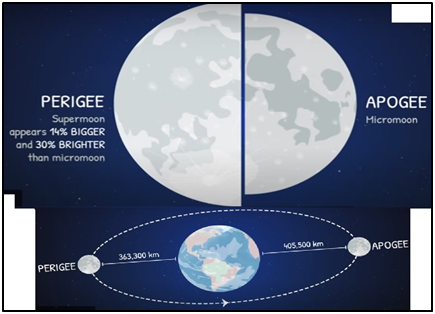Why in news?
- The Raksha Bandhan full moon on August 30-31 will be unusual: it will be both a “blue moon” and a “super moon.
- Rakhi is celebrated on the Purnima of the month of Shravan.
- Hence, it will witness the occurrence of a "Super Blue Moon," an extraordinary convergence of three celestial phenomena.
What’s in today’s article?
What is a super moon?

- The orbit of the moon around the earth is not circular; it is elliptical, that is, an elongated or stretched-out circle. It takes the moon 27.3 days to orbit the earth.
- It is 29.5 days from new moon to new moon, though.
- This is because while the moon is orbiting the earth, both the earth and the moon are also moving around the sun.
- Hence, it takes additional time for the sun to light up the moon in the same way as it does at the beginning of every revolution around the earth.
- The new moon is the opposite of the full moon — it is the darkest part of the moon’s invisible phase, when its illuminated side is facing away from the earth.
- The point closest to earth in the moon’s elliptical orbit is called perigee, and the point that is farthest is called apogee.
- A super moon happens when the moon is passing through or is close to its perigee, and is also a full moon. This happens with a new moon as well, just that it is not visible.
- A full moon occurs when the moon is directly opposite the sun (as seen from earth), and therefore, has its entire day side lit up.
- The full moon appears as a brilliant circle in the sky that rises around sunset and sets around sunrise.
- According to NASA, a full moon at perigee (super moon) is about 14% bigger and 30% brighter than a full moon at apogee (called a “micro moon”).
What is a blue moon?
- Blue moon describes the situation when a full moon is seen twice in a single month.
- Because the new moon to new moon cycle lasts 29.5 days, a time comes when the full moon occurs at the beginning of a month, and there are days left still for another full cycle to be completed.
- Such a month, in which the full moon is seen on the 1st or 2nd, will have a second full moon on the 30th or 31st.
- According to NASA, this happens every two or three years.
- It is important to note that the term Blue Moon has nothing to do with the actual colour of the moon.
- Moons can appear in various shades depending on atmospheric conditions, but a Blue Moon is not necessarily blue in colour.
- Sometimes, smoke or dust in the air can scatter red wavelengths of light, as a result of which the moon may, in certain places, appear more blue than usual.
- But this has nothing to do with the name “blue” moon.
How rare is a blue supermoon?
- According to NASA, the blue supermoons are a very rare phenomenon. It mentions that these moons often only appear once every ten years due to astronomical conditions.
- But occasionally, the interval between blue supermoons can be as long as twenty years.
- The following super blue moons will take place in pairs in 2037, in January and March.










